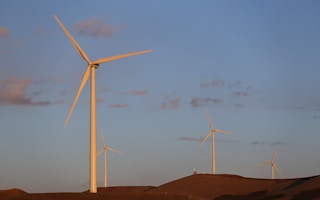As a child, Nandha Kishore S.R. was fascinated by the wind turbine installed at a wind energy institute near his home in southern India and dreamt of one day operating such equipment.
Years later, the engineering graduate trained at the same institute in Chennai and started working in the sector, first assessing India’s wind energy potential, then calculating power production and now checking site suitability for wind farms.
That helped him weather a troubled period for the industry in the past five years, which saw downsizing and stunted growth after a new bidding process for wind farm development - intended to cut the cost of power production - led to stranded projects.
To breathe fresh life into the sector, the government this year scrapped the bidding process, waived charges on the sale of wind power between states, and announced new renewable energy parks to make land available for wind-farm developers.
Kishore, 33, is now pursuing a PhD in artificial intelligence in a bid to remain indispensable as the wind power industry relies increasingly on technology - and to insulate himself from any job uncertainties in the future.
“Companies will expand, and there will be more jobs over the next few years, but the sustainability of jobs remains a question,” he said by phone from Chennai.
India aims to build 140 gigawatts (GW) of wind capacity by 2030, which could power about 100 million homes - part of its wider goal to install 500 GW of renewables by the decade’s end.
Wind is critical for India’s energy transition, as providing round-the-clock green power will require faster deployment of wind and solar energy to ensure grid resilience and balancing of different sources, said Martand Shardul, policy director for India at the Global Wind Energy Council (GWEC).
“India and other parts of the world may not be able to achieve net-zero (emission) ambitions unless wind energy is exploited to its full potential,” Shardul said.
The sector will also create employment in the world’s most populous country where tens of millions are out of work and jobs in coal are expected to decline as India weans itself off the planet-heating fossil fuel over the next couple of decades.
The Council on Energy, Environment and Water (CEEW), an India-based think-tank, estimates the South Asian nation can create about 150,000 jobs in wind by 2030 if its clean energy goals are achieved - up from about 26,000 jobs in 2021.
“
India and other parts of the world may not be able to achieve net-zero (emission) ambitions unless wind energy is exploited to its full potential.
Martand Shardul, policy director for India, Global Wind Energy Council
Vijay Yadlapalli Venkat Ramana, former chief operating office, Suzlon Global Services Limited, said the wind power sector is more labour-intensive than solar, requiring a higher level of technical qualifications and skills to build turbines and construct and maintain wind farms.
Solar plants, on the other hand, largely hire unskilled labour for cutting grass and cleaning panels.
Globally, India stands fourth in wind power capacity and aims to auction 8 GW of wind power projects per year until 2030.
“Some projects are in the early stage of construction. Jobs are already flowing in,” Ramana said.
First offshore wind farm
India is banking on wind power expansion to meet close to a third of its 2030 renewables target, with solar accounting for most of the rest.
The government has said it will soon launch a tender for the country’s first offshore wind farm in southern Tamil Nadu state, which is expected to start operating in about four years’ time.
Offshore projects will boost India’s wind supply chain and installation industry, said Dinesh Jagdale, joint secretary at the Ministry of New and Renewable Energy, noting wind will be mandated for electricity utilities as part of their energy mix.
These measures should infuse life into the sector but may not be able to create jobs quickly or at scale, analysts said.
Globally, solar and wind energy account for 7.8 million jobs, with over half of that employment in the Asia-Pacific region, according to the International Energy Agency.
In India, wind accounted for only a quarter of the more than 110,000 workers in the green energy sector as of 2021, with solar providing the rest, according to data from CEEW.
Further job creation in wind will be hindered by a lack of skills, such as those needed for marine bed surveys and building foundations in the sea for offshore wind plants as well as wider use of technology and AI for onshore facilities, analysts said.
Sumant Sinha, chairman and CEO of renewable energy producer ReNew, pointed to a “talent crunch in the industry”, flagging the need for companies to invest in skills development and training for their workers.
India is trying to bridge the talent demand-supply gap by the time offshore wind farms - with 4 GW of new capacity planned over each of the next three years - come online, by offering training at state-run wind energy institutions.
Technology, such as drones, is used to identify problems with wind turbines - but people are needed to fix any faults, noted Ajay Devaraj, secretary-general of the Indian Wind Power Association.
Domestic sales drag
In the past five years, the number of turbine manufacturers in India dropped to eight from more than 30 after the government introduced competitive bidding, known as “e-reverse auctions”, in an attempt to bring down the cost of wind power production.










